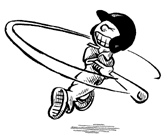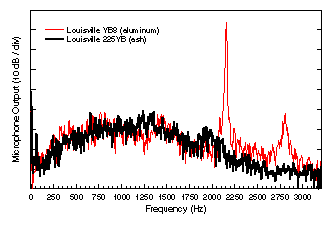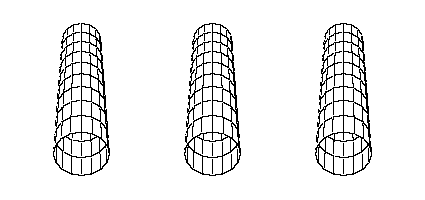
|
Physics and Acoustics of Baseball & Softball Bats
Daniel A. Russell, Ph.D. Graduate Program in Acoustics The Pennsylvania State University The contents of this page are ©2003-2011 Daniel A. Russell | 
|

|
Physics and Acoustics of Baseball & Softball Bats
Daniel A. Russell, Ph.D. Graduate Program in Acoustics The Pennsylvania State University The contents of this page are ©2003-2011 Daniel A. Russell | 
|


|
The most obvious difference between wood and aluminum baseball bats is that wood bats go "crack" when they hit a ball while aluminum bats go "ping." The figure at top left shows a plot of a microphone recording of the impact sound of a bat held at the handle and struck with a baseball at approximately the sweet spot. The sound of the wood bat has a relatively smooth frequency spectrum representative of broadband noise resulting from a short impact. The aluminum bat has almost the same smooth spectrum except for two very prominent peaks, one around 2200 Hz, which is more than 60 dB above the noise floor, and the other around 2800 Hz. The reason for this difference is that the barrel of an aluminum bat is essentially a hollow cylinder. As a result, aluminum bats have several unique cylindrical vibrational modes not found in wood bats.
The first three vibrational modes of a hollow cylinder are shown below left. In the lowest mode the barrel alternately squishes and expands. This is the vibration responsible for the "ping" sound. The second vibrational mode has a nodal circle (that doesn't move at all) and the parts of the cylinder on either side of this nodal circle move in the opposite directions. In an aluminum baseball bat the position of the nodal circle of this second vibrational mode is usually very close to the sweet zone due to the bending modes. This means that for a good hit at the sweet spot the "ping" mode is excited very strongly, but the second cylinder mode is excited only weakly. The third cylinder mode has too many adjacent regions that move in opposite directions to be an effective sound source. So, the "ping" sound is very clear, almost a pure single frequency sound resulting from the vibrational motion of the hollow cylinder. The handle of the bat does not move at all at any of these cylinder modes, so gripping the handle has no effect on the resulting cylinder vibration or the "ping." The "ping" mode of the cylinder is also responsible for the so-called "trampoline effect" which allows an aluminum bat to propel a ball farther than a wood bat. Studies have shown that a good player, who consistently makes contact with the ball at the sweet spot of the bat, can hit a ball just as far or perhaps a little farther with a wood bat as he can with an aluminum bat. The trampoline effect comes into play for poor hits away from the sweet spot. When a ball hits a wood bat away from the sweet spot the resulting bat vibrations consume energy that should have gone to the ball, and the ball does not go as far as when hit at the sweet spot. When a ball hits an aluminum bat away from the sweet spot the bending vibrations take energy away from the ball, but the cylinder vibrations return energy to the ball. The energy provided by the cylinder rebound can sometimes be greater than the energy lost to the bending vibrations. As a result a ball hit by an aluminum bat will usually go farther than a ball hit by a wood hit - especially for hits not at the sweet spot. |